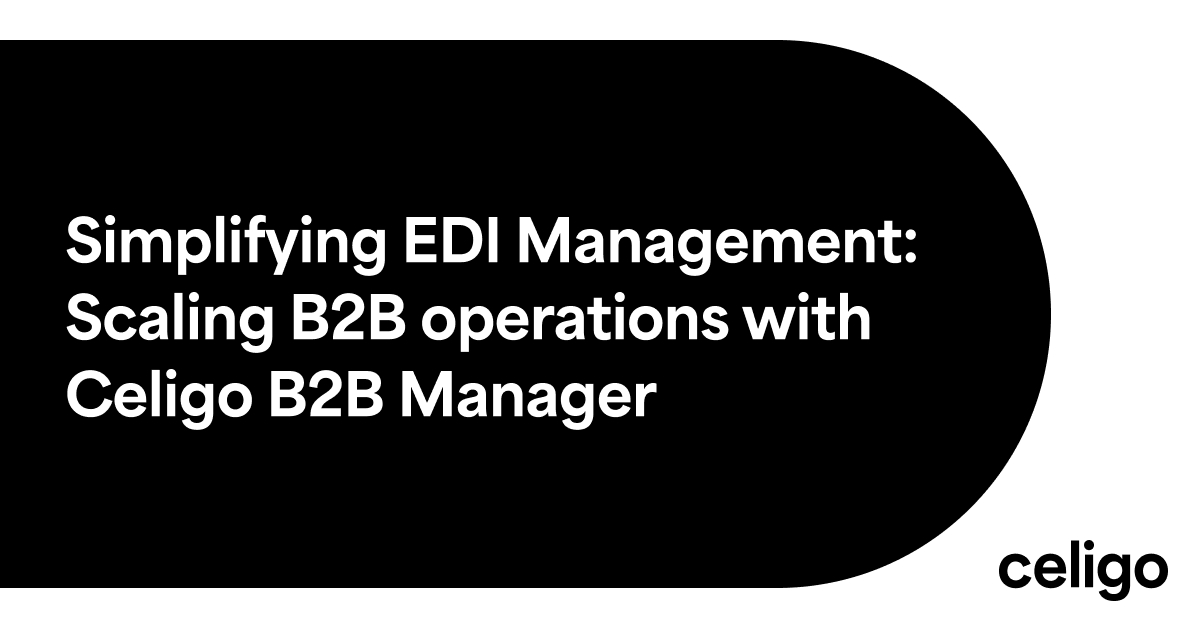Published Jan 31, 2025
A complete guide to EDI: How it works, benefits, challenges, and solutions
Electronic Data Interchange (EDI) is the technology that enables the automated, standardized exchange of business documents—such as purchase orders, invoices, and shipping notices—between trading partners. By replacing manual processes with automation, EDI eliminates errors, reduces costs, and accelerates transaction processing. It is indispensable for businesses managing high transaction volumes in retail, logistics, manufacturing, and healthcare industries.
This guide explains the fundamentals of EDI, how it works, its benefits, common challenges, and how modern EDI integration solutions can help your business scale and optimize operations.
Here, we’ll discuss:
- What is EDI? EDI (Electronic Data Interchange) automates the exchange of business documents like purchase orders and invoices between trading partners.
- How EDI works: EDI workflows include data creation, translation into standardized formats (e.g., ANSI X12), secure transmission (via AS2 or SFTP), and system integration.
- How to overcome common challenges of EDI: Legacy systems face issues like scalability limitations, onboarding delays, high operational costs, and compliance risks—but modern EDI solutions address these challenges with automation, scalability, and cost efficiency.
- Benefits of EDI integration: Modern EDI solutions improve processing speed, reduce costs, enhance accuracy, ensure compliance, and support scalability.
EDI overview
Although EDI (Electronic Data Interchange) has been used since the 1960s, it remains a critical component of modern B2B operations. EDI has transformed supply chain communication across retail, logistics, healthcare, and manufacturing industries by replacing manual, paper-based processes with standardized, automated data exchange.
EDI is projected to handle 21% of all US sales transactions by 2027, demonstrating its continued importance in supply chain automation and operational efficiency. Its ability to process high transaction volumes while ensuring accuracy and compliance makes it indispensable for mature companies managing complex trading partner networks.
How EDI works
EDI follows a structured process to enable secure and accurate document exchange:
- Data creation: A business system (e.g., ERP or accounting software) generates a document, such as a purchase order.
- Translation: EDI software converts the document into a standardized format, such as ANSI X12 or EDIFACT, to ensure compatibility between systems.
- Transmission: The translated file is securely sent to the recipient using communication protocols like AS2, SFTP, or a Value-Added Network (VAN).
- Integration: The recipient’s system processes the data, triggering workflows like inventory updates, invoice generation, or shipping notifications.
By automating these workflows, EDI eliminates manual tasks, reduces errors, and accelerates transaction processing.
Key EDI standards and communication protocols
EDI standards streamline document formatting
EDI standards define the format and structure of electronic documents to ensure consistency and compatibility. Common standards include:
- ANSI X12: Widely adopted in North America for industries like retail, logistics, and healthcare.
- EDIFACT: A global standard for international trade, commonly adopted in Europe and Asia.
- TRADACOMS: A legacy standard used in the UK retail sector.
- VDA: Primarily used in the German automotive industry.
Secure protocols ensure reliable EDI transmission
EDI transactions rely on secure transmission methods to ensure data integrity and compliance. Common protocols include:
- AS2 (Applicability Statement 2): A secure, encrypted protocol used by major retailers like Walmart.
- SFTP (Secure File Transfer Protocol): Encrypts data for secure transfers, ideal for smaller businesses.
- VAN (Value-Added Network): A managed service that facilitates data exchange, compliance, and error handling.
- HTTP/HTTPS: Suitable for lightweight or real-time EDI exchanges.
Common EDI document types
EDI automates the exchange of various business documents, improving efficiency and accuracy across supply chains. Common examples include:
- Purchase orders (850): Initiates procurement.
- Invoices (810): Requests payment for goods or services.
- Advance shipping notices (856): Provides shipment details before delivery.
- Functional acknowledgments (997): Confirms receipt and processing of transactions.
- Inventory reports (846): Shares stock updates with trading partners.
Challenges with legacy EDI solutions
Why legacy solutions are bottlenecks to growth
Legacy EDI systems—whether fully managed or traditional self-service—struggle to meet the demands of modern supply chains. They lack the flexibility, scalability, and efficiency required for businesses to adapt to evolving market conditions.
The high cost of traditional EDI
Traditional EDI solutions often come with escalating costs:
- Transaction-based fees: Fully managed EDI providers frequently charge per transaction, leading to unpredictable expenses as businesses grow.
- Customization fees: Adjustments for trading partner configurations or compliance updates often incur additional costs.
- IT resource dependency: Self-service EDI requires skilled IT teams, adding to operational overhead.
- Hidden costs: Troubleshooting errors, onboarding partners, and maintenance fees further drive up expenses.
Fully managed EDI limits visibility and control
Fully managed EDI solutions outsource operations to third-party providers, reducing internal burdens but creating new challenges:
- Lack of visibility: Businesses have limited access to monitor workflows or resolve issues.
- Delayed updates: Even minor changes require provider intervention, slowing down operations.
- Lengthy onboarding timelines: Rigid processes delay trading partner integrations, impacting revenue generation.
Traditional self-service EDI increases complexity
While self-service EDI offers more control, it often requires technical expertise that creates barriers for many businesses:
- Complex integrations: Data mapping, ERP integrations, and trading partner setup require specialized knowledge.
- Poor usability: Legacy tools are not user-friendly, leading to inefficiencies and delays.
- Resource strain: As trading partner networks expand, IT teams face increased workloads, diverting resources from strategic initiatives.
How modern EDI integration solves these challenges
Modern EDI integration solutions address the limitations of legacy systems by streamlining operations, enhancing visibility, and automating workflows. Unlike traditional solutions, which are either too rigid (fully managed) or too complex (self-service), modern EDI integration provides businesses with flexibility, scalability, and control.
1. Automating workflows
EDI integration eliminates repetitive manual processes by automating the exchange of business documents such as purchase orders, invoices, and shipping notices. For example:
- When a trading partner sends a purchase order (EDI 850), the system automatically updates inventory levels, generates a sales order, and creates an invoice.
- These workflows reduce human intervention, ensuring faster and more accurate transactions.
2. Standardizing data formats
With integrated EDI solutions, businesses can automatically convert documents into standard formats such as ANSI X12 or EDIFACT. This ensures seamless communication with trading partners, even if their systems differ. Businesses reduce errors and ensure compliance with partner requirements by eliminating the need for custom formatting.
3. Ensuring secure data exchange
Modern EDI solutions utilize secure protocols like AS2, SFTP, or VANs to transmit sensitive business data. These protocols provide encryption, authentication, and data integrity, reducing the risk of breaches or data loss. Secure data exchange protects businesses and strengthens trust with trading partners.
4. Enhancing visibility with real-time dashboards
Legacy systems often lack visibility into transaction statuses, errors, or compliance gaps. Modern EDI integration offers centralized dashboards that provide real-time insights into transaction workflows.
- Businesses can proactively identify and resolve errors before they escalate.
- Compliance statuses are readily available, helping businesses avoid penalties or chargebacks.
5. Simplifying onboarding and partner management
Integrating EDI with ERP or CRM systems enables faster onboarding of new trading partners. Prebuilt templates and connectors reduce the time it takes to configure new integrations, allowing businesses to adapt to changing supply chain requirements quickly.
Benefits of modern EDI solutions
Modern EDI solutions go beyond traditional methods by offering advanced automation, real-time data exchange, and cost efficiency. The benefits of EDI integration include error reduction, faster transaction processing, and improved supply chain visibility—helping businesses enhance operational efficiency, strengthen partner relationships, and accelerate cash flow in today’s fast-paced market.
1. Faster transaction processing
Automating the exchange of documents like purchase orders, invoices, and shipping notifications accelerates transaction cycles. For example, an automated EDI workflow can reduce order processing time from days to hours, enabling faster fulfillment and improved customer satisfaction.
2. Cost efficiency
Modern EDI solutions eliminate many of the costs associated with legacy systems, including:
- Labor savings: Automation reduces the need for manual data entry or troubleshooting.
- Predictable pricing: Many modern solutions, such as Celigo’s B2B Manager, offer flat-rate pricing, eliminating transaction-based fees and hidden costs.
- Lower IT overhead: Prebuilt connectors and templates minimize the need for costly IT resources.
3. Improved accuracy and compliance
Automation significantly reduces manual errors, ensuring smoother transactions and fewer disputes with trading partners. Additionally, modern solutions help businesses stay compliant with industry standards like HIPAA, EDIFACT, or ANSI X12, reducing the risk of penalties and chargebacks.
4. Scalability for growing businesses
Modern EDI solutions are designed to handle increasing transaction volumes and expand alongside trading partner networks. As businesses grow, these solutions provide the flexibility to onboard new partners, support complex workflows, and manage higher transaction loads without additional overhead.
5. Enhanced user experience
Unlike traditional EDI tools that require extensive technical knowledge, modern solutions are designed with usability in mind. Intuitive interfaces allow non-technical users to monitor workflows, resolve errors, and configure trading partner integrations without IT intervention.
6. Real-time monitoring and insights
Centralized dashboards in modern EDI solutions provide real-time monitoring of transaction statuses, error notifications, and compliance statuses. This visibility enables proactive issue resolution, reducing downtime and ensuring uninterrupted operations.
7. End-to-end automation
Modern EDI solutions integrate seamlessly with ERP, CRM, and inventory management systems to enable complete automation of workflows. For example, when a purchase order is received, the system can trigger an inventory update, generate an order acknowledgment, and create an invoice—all without manual input.
Simplifying EDI integration with Celigo’s B2B Manager
Celigo’s B2B Manager simplifies EDI processes by offering:
- Prebuilt templates: Speeds up onboarding with ready-to-use EDI formats.
- Centralized dashboards: Provides real-time visibility into transaction workflows.
- End-to-end automation: Integrates EDI with ERP and CRM systems to eliminate manual steps.
- Scalability: Supports increased transaction volumes and growing partner networks.
EDI remains the backbone of efficient B2B communication, enabling businesses to streamline operations and scale effectively. Modern EDI solutions, like Celigo’s B2B Manager, eliminate the challenges of legacy systems by combining control, simplicity, and scalability.
Integration insights
Expand your knowledge on all things EDI. Discover expert guidance, tips, and best practices with these resources.



